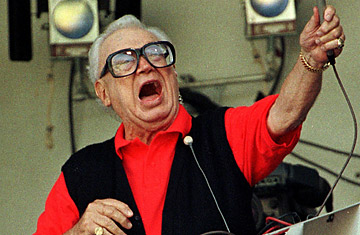
Chicago Cubs baseball announcer and Baseball Hall of Famer Harry Caray conducts fans singing "Take Me Out to the Ball Game" in 1997.
America's favorite pasttime has more than its share of beloved traditions: pine tar and linseed oil, chewing tobacco, the infield-fly rule. But few are as hallowed as the singing of "Take Me Out to the Ballgame" during the seventh-inning stretch by stadiums full of musically challenged, slightly boozy baseball fans. And the song itself, like the tradition, has surprisingly deep — and equally loony — roots. (See the 10 worst ceremonial first pitches.)
Take its creators, for instance. Jack Norworth, the lyricist, started his career doing minstrel shows and vaudeville acts at the turn of the 20th century, just as baseball was making a name for itself. The National Association of Base Ball Players had been established in 1858 and Major League Baseball itself would be founded in 1903. One day while riding a New York subway, Norworth saw a sign that read "Baseball Today — Polo Grounds." And in 15 minutes, he had scribbled the words of his fun-time anthem on the back of an envelope — now on display at the National Baseball Hall of Fame in Cooperstown, N.Y. The original 32-line ditty has been greatly distilled down to the version we know today, but lost a lot in the translation. Norworth's first draft included some extremely helpful context: that the song was sung from the point of view of one Katie Casey (whom he later renamed Nelly Kelly), a baseball fanatic trying to get her boyfriend to take her to a game instead of a show. These days, most baseball fans only know Katie's plaintive chorus:
Take me out to the ballgame,
Take me out with the crowd.
Buy me some peanuts and Cracker Jack,
I don't care if I ever get back,
'cause it's root, root, root for the home team,
if they don't win it's a shame.
For it's one , two, three strikes you're out, at the old ballgame.
But Norworth still needed music to accompany his verse. He sought the help of his friend Albert von Tilzer, a Broadway songwriter and the creator of popular songs like "The Alcoholic Blues" and "I May Be Gone for a Long, Long Time," whose waltz-like melody made the tune complete. On May 2, 1908, the U.S. Copyright Office received two copies of their song — and most likely filed them away with the hundreds of other odes to baseball that had come before it. (Among the less popular: the largely forgotten "Baseball Polka," created by a Buffalo ballplayer.) "Take Me Out to the Ballgame," on the other hand, never quite went away. Norworth and von Tilzer peddled the song to vaudeville; actors, singers and even acrobats used it in their acts and it was even played during intermissions at nickelodeons, or early movie theaters. According to several historical references, neither man had ever even been to a baseball game.
And so "Take Me Out to the Ballgame" became popular because of popular music and entertainment and not because of baseball. It wasn't part of any regular tradition as it is these days, but it struck a sentimental chord with baseball fans, reminding them of the glory and heroism of legendary players like Babe Ruth, Ted Williams and Jackie Robinson. In 1958, on the song's 50th anniversary, MLB gave Norworth — who had finally attended his first game in 1940 — a gold lifetime ball park pass.
It wasn't until the 1970s that the song found its current exalted status as baseball's alternative anthem, thanks to Hall of Fame broadcaster Harry Caray, then an announcer at Comiskey Park, home of the Chicago White Sox. Sitting in his booth, Caray would often sing "Take Me Out to the Ball Game" with nearby fans. One day, then-owner Bill Veeck noticed the impromptu choir. The following game, he outfitted Caray's booth with a secret microphone, and a tradition was born. Caray eventually moved to Wrigley Field with the Chicago Cubs, bringing his seventh-inning singing with him; today, the tradition happens in almost every ballpark. "Take Me Out to the Ballgame" is believed to be one of the most performed songs in America, behind "Happy Birthday" and "The Star Spangled Banner."
After Caray's death in 1998, the Cubs began inviting special guests to lead Cubs fans in an often excruciating attempt to carry on his legacy. Among the tune's most recent mutilators are racing star Danica Patrick, a northern Illinois native who rooted for the home team in 2006; the hoarse and possibly inebriated Eddie Vedder, who sounds like he's asking someone to buy him "some peanuts and crack;" and in an appalling lack of judgment by the Cubs front office, Ozzy Osbourne, who sang not a single word of the song correctly. Thankfully, no chickens were harmed. And mysteriously famous American Idol castoff William Hung? Perhaps it's better to forget that altogether.
